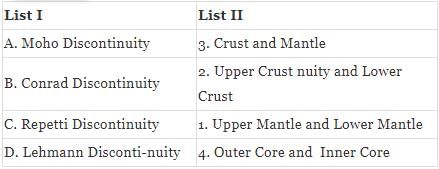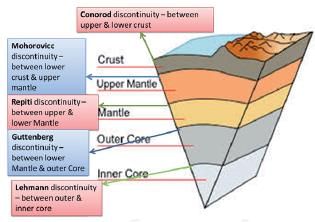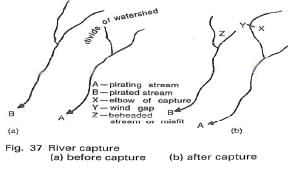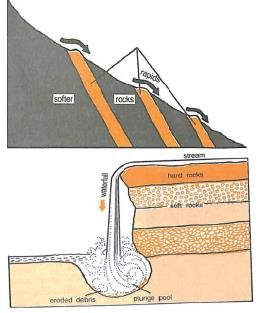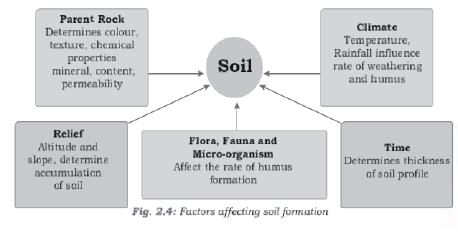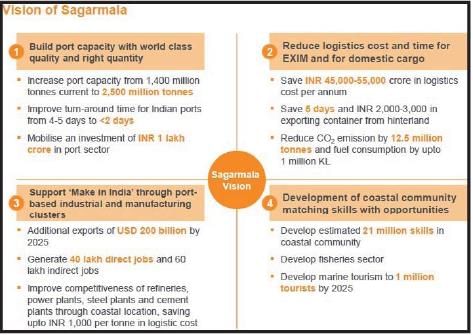Test: Geography - 5 - UPSC MCQ
30 Questions MCQ Test - Test: Geography - 5
With reference to the Sea Floor Spreading, consider the following statements:
1. It is a process in which new oceanic crust forms gradually through continuous volcanic eruptions.
2. The force involved in this process is convective current.
Which of the above statements is/are correct?
1. It is a process in which new oceanic crust forms gradually through continuous volcanic eruptions.
2. The force involved in this process is convective current.
Which of the above statements is/are correct?
Which of the following statements regarding El Nino is/are correct?
1. El Nino results into high pressure over west Pacific and thus causes droughts in Eastern Australia.
2. El Nino affects the weather conditions of the entire tropical region.
Select the correct answer using the code given below:
1. El Nino results into high pressure over west Pacific and thus causes droughts in Eastern Australia.
2. El Nino affects the weather conditions of the entire tropical region.
Select the correct answer using the code given below:
| 1 Crore+ students have signed up on EduRev. Have you? Download the App |
Consider the following statements regarding Jute Cultivation:
1. The suitable climate for growing jute is a warm and wet climate.
2. Sandy loams and clay loams are most suitable for jute cultivation.
Which of the above statements is/are correct?
1. The suitable climate for growing jute is a warm and wet climate.
2. Sandy loams and clay loams are most suitable for jute cultivation.
Which of the above statements is/are correct?
Match the following discontinuities with their positions in interior of the earth:
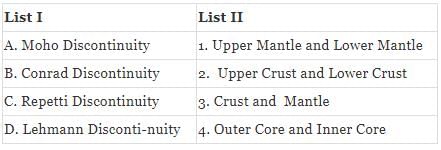
Select the correct answer using the given code below:

Consider the following statements with reference to Alluvial Soils:
1. Khadar is the older alluvium deposited away from the flood plains.
2. Bhangar is new alluvium deposited by floods.
Which of the above statements is/are correct?
Consider the following statements regarding the Asteroids:
1. Asteroids are found between the orbits of Mars and Saturn.
2. Asteroids exhibit the process of outgassing while passing close to the sun.
Which of the above statements is/are correct?
Consider the following statements regarding fluvial landforms:
1. Waterfalls are found only in the mountain course of a river.
2. River piracy occurs due to different rate of headward erosion into a river divide.
3. Cataracts are large and deep holes at the base of a waterfall.
Which of the above statements is/are incorrect?
Consider the following statements with reference to winds:
1. Local winds are confined to the lower level of the Stratosphere.
2. Foehn is a strong, dry and warm local wind which develops on the windward side of the Alps.
3. Mistral brings down the temperature below freezing point in areas of their influence.
Which of the above statements is/are correct?
Consider the following statements regarding the Submarine Trenches and Deeps:
1. These are tectonically formed and are found along the constructive plate margins.
2. The largest number of deeps and trenches are found in the Atlantic Ocean.
Which of the above statements is/are correct?
Which of the following statements is/are incorrect regarding Caves formation in Karst Topography?
1. Caves formation is prominent in the areas with alternative bed of Shales and Sandstones rocks.
2. In areas, where Limestone are dense and occurring as thick beds, cave formation is prominent.
Select the correct answer using the code given below:
With reference to Jet Streams, consider the following statements:
1. Jet streams are narrow bands of fast moving winds in the upper levels of atmosphere.
2. They flow from west to east.
Which of the above statements is/are correct?
Which of the following statements is/are correct regarding Block Mountains?
1. These Mountains are the result of compressive forces, triggered by the endogenetic forces.
2. These are also called Horst Mountains.
Select the correct answer using the code given below:
Which of the following features are created by Himalayan Rivers in their mountainous course?
1. Gorges
2. V-shaped Valleys
3. Ox-bow Lakes
4. Waterfalls
Select the correct answer using the code given below:
Consider the following statements regarding the factors affecting soil formation:
1. The composition of the soil profile is directly influenced by the composition of the parent rocks.
2. Climate determines the thickness of soil profile.
Which of the above statements is/are correct?
Which of the following statements are correct regarding Suitable conditions for wheat cultivation in India:
1. Wheat thrives well in areas receiving an annual rainfall of about 75 cm.
2. The temperature should be high at the time of sowing.
Select the correct answer using the code given below:
Consider the following statements regarding Limestones:
1. Limestone is a sedimentary rock of organic origin.
2. Dolomite is a type of limestone where magnesium is present along with calcite.
3. During orogeny, limestone recrystallizes into shale.
Which of the above statements is/are correct?
Consider the following statements regarding Inter-Tropical Convergence Zone (ITCZ):
1. It is the zone of clam and windless weather.
2. It generates vigorous thunderstorms over large areas.
Which of the above statements is/are correct?
Which of the following statements is/are correct regarding National Clean Air Programme (NCAP)?
1. It aims to reduce particulate matter (PM) pollution by 20-30% in at least 102 cities by 2024.
2. Most of the cities chosen under this initiative are Tier-One cities.
Select the correct answer using the code given below:
Consider the following statements about the Northern Plain of India:
1. They are formed by the alluvial deposits brought by the rivers – the Indus, the Ganga, and the Brahmaputra.
2. It supports a variety of crops like wheat, rice, sugarcane and jute.
Which of the above statements is/are correct?
The rising and the setting sun appears red due to the phenomenon of:
Consider the following statements regarding Particularly Vulnerable Tribal Groups (PVTGs) in India:
1. Andaman & Nicobar is the only UT to consist of PVTGs.
2. PVTGs are categorized by Ministry of Tribal Affairs.
3. Existence of pre-agricultural level of technology is one of the criteria for determining PVTG status.
4. Kota and Toto tribes are included in the list of PVTGs.
Which of the above statements are correct?
Which of the following statements are correct about Meanders?
1. These are formed when load-carrying capacity of the river increases drastically.
2. Ox-bow lakes are the result of meandering rivers.
3. Its concave bank is known as cut-off bank and convex bank as slip-off bank.
Select the correct answer using the code given below:
With reference to Reforestation, consider the following statements:
1. Reforestation is establishment of trees in an area where no previous tree cover exists.
2. Reforestation can be used to rebuild natural habitats and mitigate global warming.
Which of the above statements is/are correct?
Consider the following statements regarding Tropic of Capricorn:
1. Its northern hemisphere equivalent is Tropic of Cancer.
2. It passes only through South American and African Countries.
3. Atacama Desert, Andes Mountains are located on Tropic of Capricorn.
Which of the above statements is/are correct?
With reference to ‘Asteroid’, which of the following statements is/are correct?
1. The region between Mars and Jupiter is called Asteroid belt.
2. Asteroids are made of dust and ice only.
Select the correct answer using the code given below:
Consider the following statements:
1. The highest surface water temperatures are recorded at equator since it receives direct sun rays throughout the year.
2. The Red Sea has a higher surface water temperature than adjoining Arabian Sea.
Which of the above statements is/are correct?
Which of the following factors is/are responsible for weather formation of particular place?
1. Temperature
2. Atmospheric Pressure
3. Latitude
4. Precipitation
5. Topography
Select the correct answer using code given below:
The Nilgiris along the west coast are relatively tectonically stable as compared to the Himalayas; but, still, debris avalanches and landslides occur in these hills. Why?
1. Many slopes are steeper with almost vertical cliffs and escarpments in the Western Ghats and Nilgiris.
2. Mechanical weathering due to temperature changes and ranges is pronounced in Nilgiris.
3. Nilgiris is mostly made up of sedimentary rocks and unconsolidated and semi consolidated deposits.
4. Nilgiris receive heavy amount of rainfall over short periods.
Select the correct answer using the code given below:
Match the following pairs:
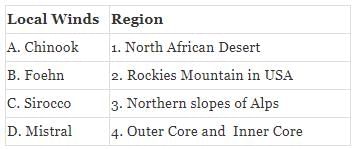
Select the correct answer using the code given below:

Consider the following statements with reference to vision of Sagarmala project:
1. To increase the turn-around time for India ports.
2. To promote port based industrial and manufacturing clusters.
3. Coastal Community Development through skill development and livelihood enhancement.
Which of the above statements is/are correct?


